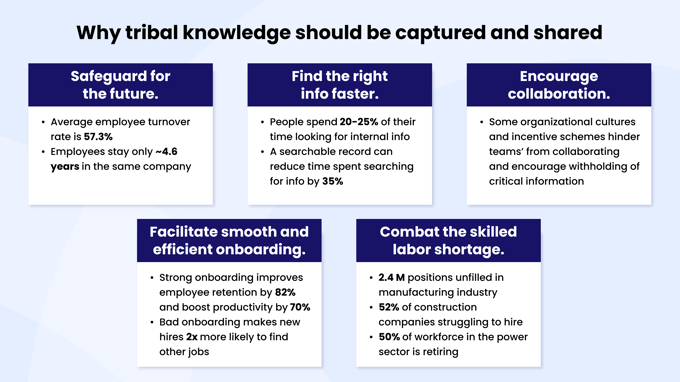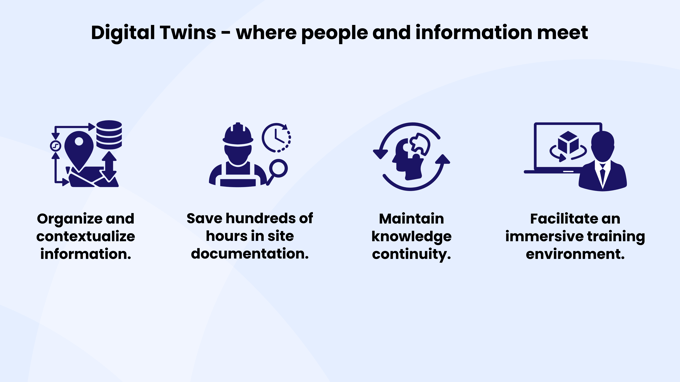Have you ever tweaked a recipe that made a dish even better than the original? But you never wrote down the changes you’ve made, so you can never get it quite right when you try to recreate it?
Imagine that happened to your company? Think about your best employee who knows all the ins and outs of the business or knows all your clients and how to keep them happy. Suddenly, that employee is gone, taking with them all that knowledge and experience. What happens to the business then?
What is tribal knowledge?
These scenarios all share a common theme: tribal knowledge. It’s the private knowledge stored in the minds and hands of members of a particular “tribe”. Gatekeepers are people who prevent this tribal knowledge from being shared with people outside the tribe.
Tribal knowledge is not just common in cooking recipes but also in all organizations where data and information are not centralized and not typically shared outside of different departments. It may be stuck on a sticky paper note, lost in a notes app, or buried in memory.
Examples of tribal knowledge in an organization could be as basic as account passwords, how to use the office printer, or whom to approach in HR when you have problems. Or it could be more complex and have a bigger impact on the business, like having the right connections with suppliers or partners, the know-how and experience gained from past projects, or secrets of the trade.
Why tribal knowledge should be captured and shared
1. Safeguard for the future.
Like it or not, employees are not going to stick around forever. They might resign, switch jobs, or eventually retire. According to the Bureau of Labor Statistics report in 2021, the US average turnover rate was 57.3% and employees stay only ~4.6 years in one company. Turnover is inevitable. Employees have the right to spread their wings and fly, but don’t let the knowledge and wisdom they have gained just slip through your fingers. Make sure your employees constantly digitize, update, and organize their work files in shared drives to help facilitate smoother turnovers. Some companies even practice monthly sessions where select employees share their experiences or best practices in the field.
2. Facilitate smooth and efficient onboarding.
Keeping company processes and product information well-documented and organized can contribute to smooth and efficient self-onboarding. As a continuation of the previous point, inheriting the complete work records of a previous employee can save your new hires a lot of time and effort as they would not have to start completely from scratch. Organizations with strong onboarding programs can improve employee retention by 82% and boost productivity by 70%. On the other hand, employees who did not enjoy their onboarding experience are twice more likely to explore new job opportunities in the near future.
3. Find the right info faster.
Don’t let your employees waste their time trying to find the right person with the right information they need. The average worker spends 20% (or even up to 25%) of their time looking for internal information or tracking down the right person to help with tasks. To put things in perspective, that’s equivalent to one whole work day or more. McKinsey reports that a searchable record of knowledge can reduce the time employees spend searching for information by as much as 35%.
4. Combat the skilled labor shortage.
Your skilled workers on the ground carry with them years and even decades worth of experience. Unfortunately, these workers are running short as the older generations are retiring with fewer people joining them. In the manufacturing industry, there is an estimated 2.4 million positions unfilled. In the construction industry, 52% of companies are struggling to find laborers, carpenters, and equipment operators, while 28% of them have a hard time hiring project managers and supervisors. In the power industry, 50% of the workforce will have retired by 2023 to 2028. Skills and experience are not easily preserved, but giving your experts a platform to share and teach young recruits is already a step in the right direction. (We'll share more about this in the next section.)
5. Encourage collaboration.
A company that actively encourages knowledge sharing and provides employees a space to do so can cultivate a culture of teamwork and unity throughout the whole organization. Don’t create an atmosphere where employees and teams feel like they have to compete against each other in an unhealthy way, like competing for limited promotions or racing against each other for awards and bonuses. People can be motivated to harbor critical information at the expense of another team, and ultimately, at the expense of the company’s bottom line.

Digital Twins - where people and information meet in the virtual world
Tribal knowledge is a precious resource that often gets overlooked until it’s too late. Earlier, we briefly mentioned some common strategies companies use to document tribal knowledge, such as a centralized, searchable resource center, knowledge-sharing sessions, employee turnover requirements, a collaborative work culture, etc. You can find a lot of articles talking about how to capture tribal knowledge. We’re proposing a new solution. Imagine how much more easy and useful information could be with a digital twin solution?
Digital Twins can make documentation and training a fun, interactive, and immersive experience.
- Organize information, documents, etc. in the right spatial or visual context. - Enterprises deal with a tremendous amount of data and files. With a digital twin, you can contextualize information by anchoring it spatially in a 3D virtual space, like in real life.
- Save hundreds of hours in site documentation. - Your mission-critical facilities themselves hold tons of valuable information that need to be captured and shared. But documenting and manually patching up site information is massive work. With Beamo, you can automatically stitch your pictures and media, with location information, directly on an interactive floor plan to speed up documentation. Add layers of annotations and complementary information about field conditions directly while onsite.
- Maintain knowledge continuity. - Build up your knowledge base and make it a living, breathing platform for current and future generations of employees. Beamo allows teams to interact and collaborate with each other. It can transform into a digital watering hole or nexus for your employees (whether remote or onsite) to meet each other, update tasks, exchange new information, search for past records, share issues, get useful tips from experts, etc.
- Facilitate an immersive training environment. - Allow your new hires to self-onboard remotely but still experience the onsite environment virtually. Our clients report that 96% of trainees found education materials more useful and understandable when placed in a 3D digital twin.
In addition, Beamo’s digital twin solution has powerful, enterprise features to make information accessible yet secure. Allow users (on-the-ground and remote) access to real-time information and keep objectives aligned. Make sure spaces and information are shared with the right teams.

Conclusion
Digital twins are an innovative solution to document, share, and update tribal knowledge and critical information and inspire collaboration within and across teams. It’s also a comprehensive and immersive solution to onboard new recruits.
Read on about how our client, a major semiconductor manufacturer, is using Beamo as a framework for immersive information management.
Or about how another client, a major Japanese airline, is digitizing their training program through Beamo.